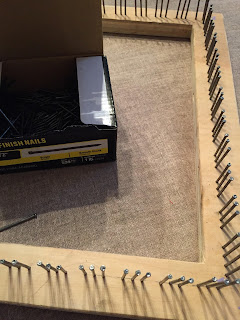Not to toot my own horn, but I can knit pretty much anything. Cables and fair-isle, socks and mittens, sweaters and hats. I was lucky and learned when I was in third grade in an after school enrichment program, so when I picked it up again three or four years ago I sort of sped to the front of the class (along with my BFF Corinne. Hi Corinne!! 😘.) We busted through a few dishcloths, but were pretty quickly on to bigger projects.
I was at Joann Fabrics a few months before I got married, so about three years ago, and saw the cover of Vintage Design Workshop, by Geraldine Warner. It's worth looking at, but I'm not reposting it here because I don't know if I'm allowed to and I'm not letting anything hurt my chances at my own daytime TV show (or my 2032 presidential run.) The cover showcases this really cool 1950s short sleeve sweater that made me swoon, but I didn't remember enough about knitting to really do anything about it. So I put out an emergency status on Facebook that I needed to learn how to knit. I was actually looking to pay someone for lessons (BECAUSE CRAFTING IS A SKILL AND AN ART AND WE DESERVE PAYMENT AND WE'RE NOT JUST FREE THING FACTORIES) but I was lucky to have a friend's mom (Thanks Mrs. Whitehouse!!) volunteer to just do it out of the kindness of her heart, which is kind of amazing giving the life changer it was for me.
But that was kind of a digression. Here we are, 2017, and I can knit pretty much anything. BUT. I don't. Dishcloths remain a personal favorite. People sometimes make fun of me when they see me knitting one, but that's fine. My friend Matt and I were making hemp bracelets once and he said something along the lines of, "People might make fun of me for learning how to make hemp bracelets, but whatever, you're sitting over there being mean and I have a new skill." I think it may have involved more colorful language but I'm keeping this blog family friendly. So anyway, don't let anyone stop you from knitting cotton squares if that's what you want to do. When the apocalypse comes, everyone in my compound will have washcloths and homemade soap. (Soap will be another post so your compound can be clean as well.)
Here's the deal with these squares for the uninitiated: you go to the store, get some Sugar and Cream cotton yarn, and knit it on some pretty big needles. (7 or 8 or 9). You can use them to dry dishes, wipe down your counter, as a trivet, or like I use mine, in the shower! (Ooh lala!) They're pretty scrubby and exfoliating and I need that since I'm part knitter but also part molting cryptid reptile woman.
If you don't know how to knit yet, this is a great place to start. In a future post, I could show you the bias-knit dishcloth pretty much everyone learns first and it barely even has a pattern and eventually you just memorize it and keep some cotton yarn and needles in your bag in case you get stuck somewhere where you need to knit. But this weekend I decided on our drive to Rhode Island (oh yeah, I went to Rhode Island!) I'd work on this Lily's Sugar and Cream pattern I'd had my eye on: Raindrop Dishcloth. (Or as I like to call it, Tears of My Enemies Dishcloth) This is for someone who knows at least basic knitting. Pattern is free though and you probably already have the needles and ten pounds of cotton yarn, if you're anything like me.
I finished it up last night! It probably took about 6 hours total, maybe less. I am going to start timing my knitting but not today.
 |
| I actually think mine looks better than the examples they give on the website... Want to hire me, Sugar and Cream?! |
 |
| LOOK AT THAT EDGE. SOMEONE HIRE ME TO BE A TEST KNITTER. |
In addition to being really cute, those little eyelets in the raindrops really catch the water to make suds!
 |
| Harder to capture bubbles on camera than I thought. But they're there. |
 |
| Drops are much more defined after a dip! |
If knitting seems like something you'd be interested in, but you don't know where to start, I suggest doing what I did and putting it out there on social media. You may not get as lucky as I am to get someone volunteering to help you learn for free, but you will probably find someone willing to do it for money, beer, or pictures of cats. Also someone might make fun of you for learning to knit, but they're just jealous they don't have the drive to learn a new skill. You might also try reaching out at work. We have a knitting circle that's just getting started up, and we were surprised at the interest!
In closing, here is a behind the scenes look at my cat watching Brett take pictures of me trying to make lather in the sink, and wondering what weird stuff the humans are into now.
 |
| You people are sick. |











